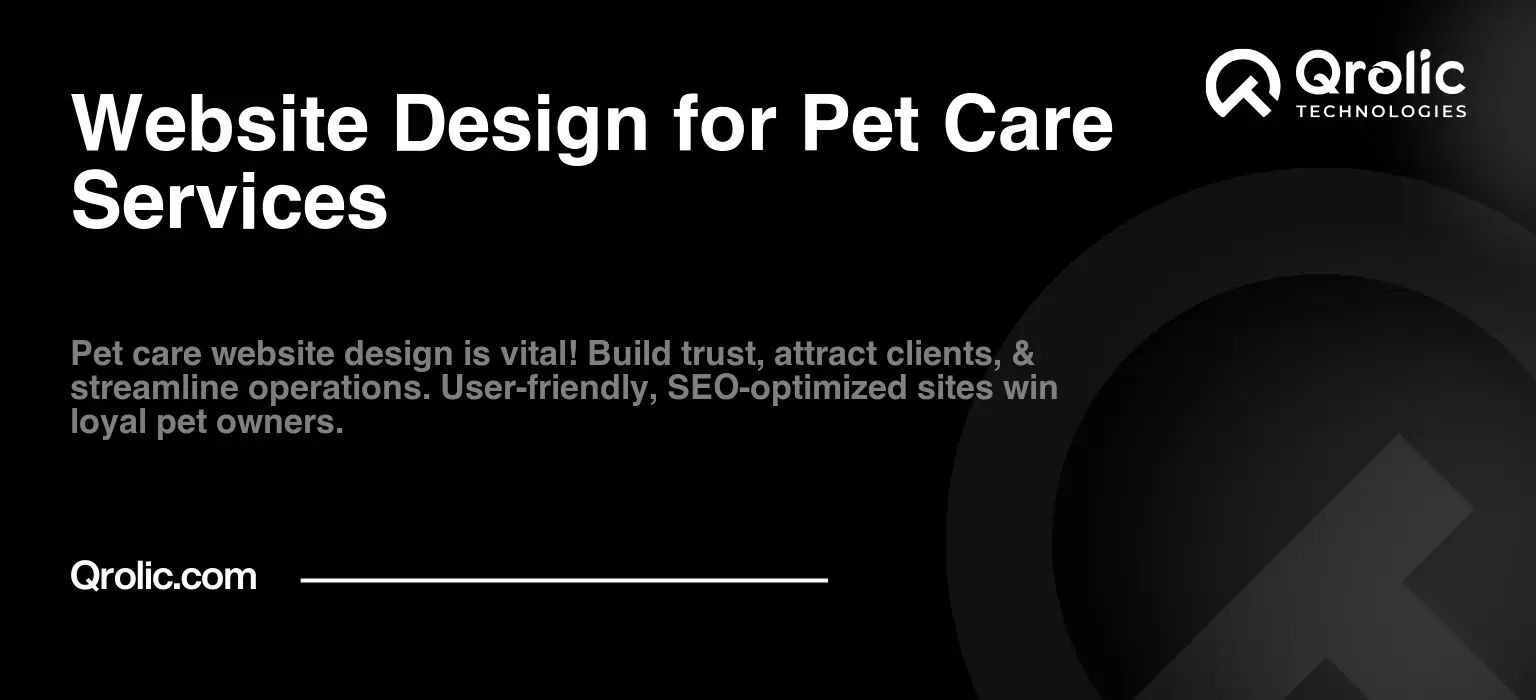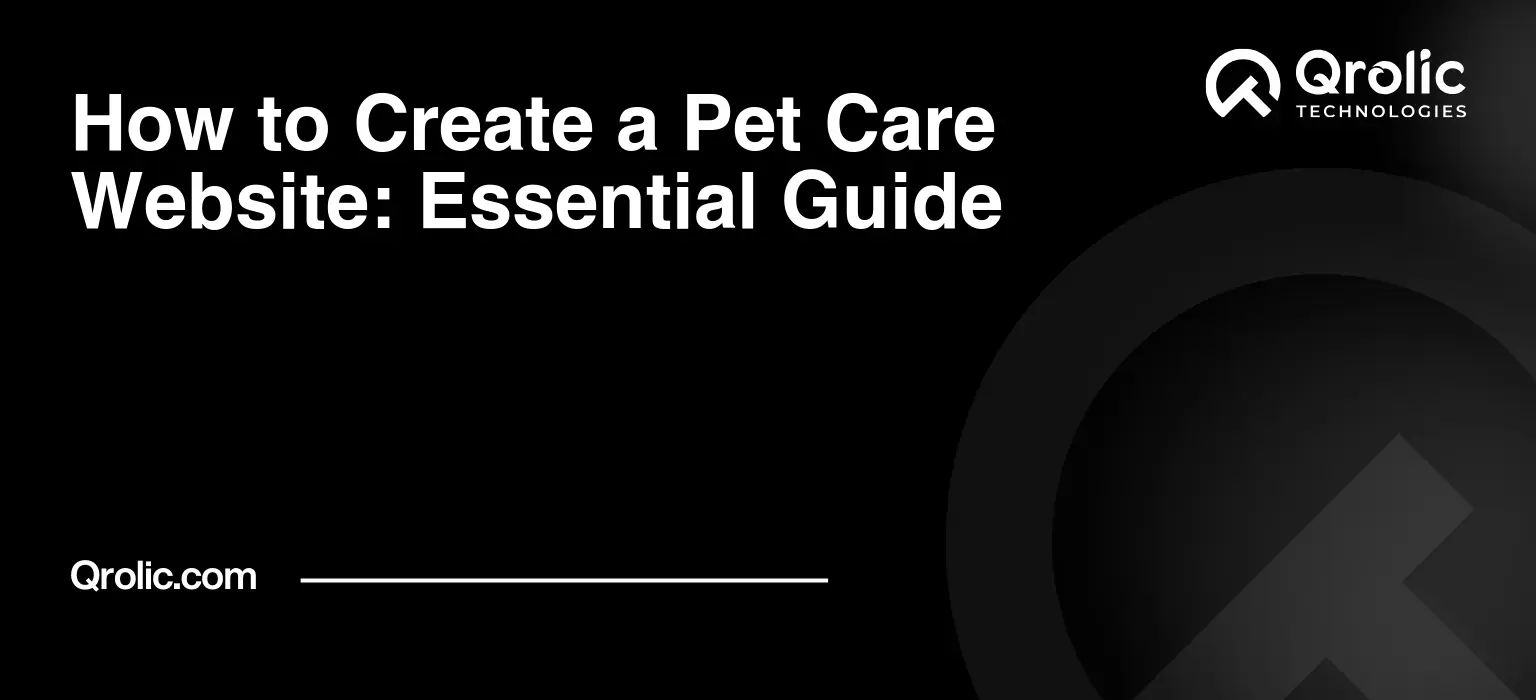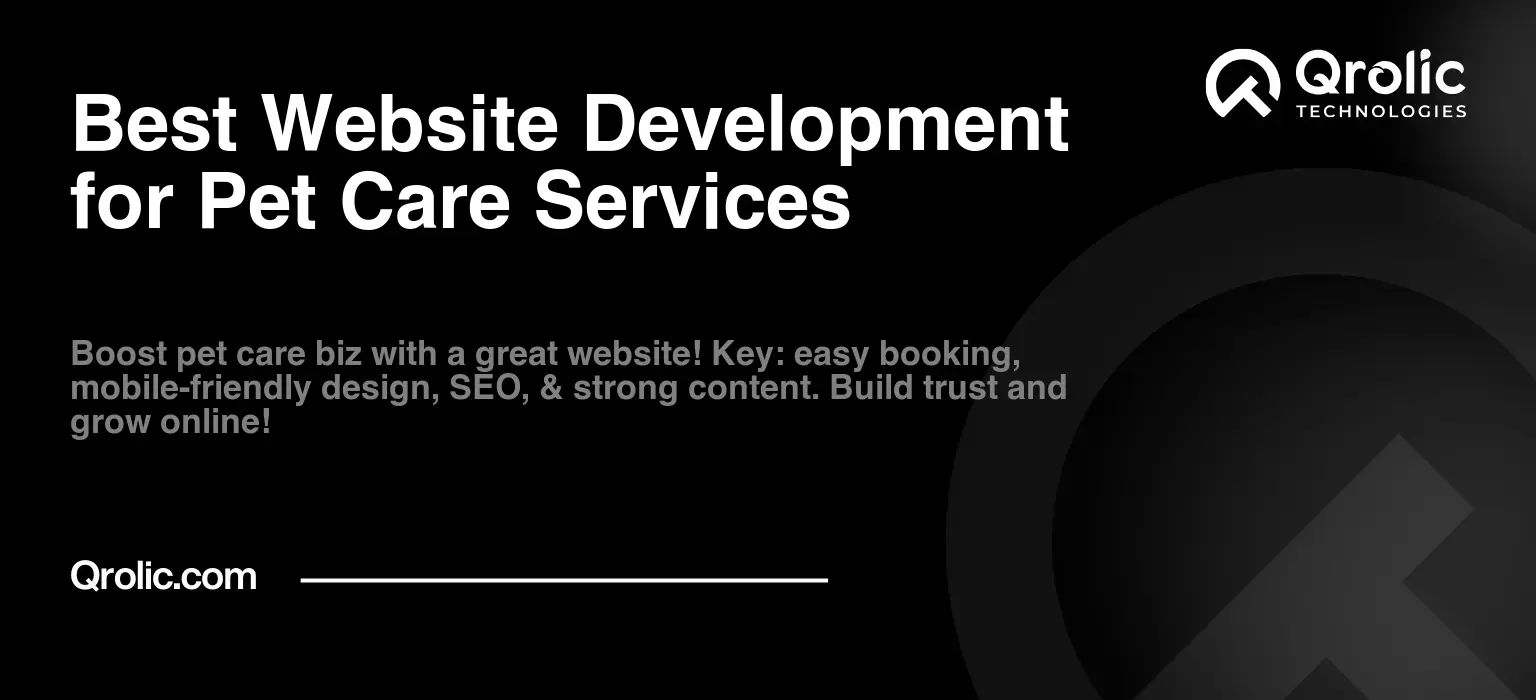Quick Summary:
- Your website is vital for building trust and attracting clients.
- Design it to be user-friendly, visually appealing, and informative.
- Use SEO and key features like online booking to succeed.
Table of Contents
- The Heart of Your Online Presence: Why Website Design Matters for Pet Care
- 1. Building Trust and Credibility
- 2. Attracting New Clients
- 3. Streamlining Operations and Enhancing Communication
- 4. Standing Out From the Competition
- Key Elements of an Effective Pet Care Website Design
- 1. User-Friendly Navigation
- 2. Visually Appealing Design
- 3. Engaging Content
- 4. Essential Functionality
- SEO Strategies for Pet Care Websites: Reaching Your Target Audience
- 1. Keyword Research: Understanding What Pet Owners are Searching For
- 2. On-Page Optimization: Making Your Website Search Engine Friendly
- 3. Content Marketing: Creating Valuable Resources for Pet Owners
- 4. Link Building: Earning Authority and Credibility
- 5. Local SEO: Targeting Pet Owners in Your Area
- Animal Service Web Development: Tailoring Your Website to Specific Needs
- 1. Veterinary Website Design: Caring for Pets Online
- 2. Animal Shelter Website Design: Finding Forever Homes
- 3. Pet Grooming Website Design: Showcasing Style and Expertise
- 4. Dog Training Website Design: Building Better Bonds
- Veterinary Website Design: A Specialized Approach
- 1. Building Trust and Credibility
- 2. Providing Valuable Information
- 3. Streamlining Communication
- 4. Key Features for Veterinary Websites
- Optimizing the User Experience (UX) for Pet Owners
- 1. Understanding Your Target Audience
- 2. Simplifying Navigation
- 3. Creating Engaging Content
- 4. Ensuring Mobile Responsiveness
- 5. Accessibility
- Qrolic Technologies: Your Partner in Pet Care Website Design
- Why Choose Qrolic Technologies?
- Services Offered by Qrolic Technologies
- Measuring the Success of Your Pet Care Website
- 1. Key Performance Indicators (KPIs)
- 2. Tools for Tracking Website Performance
- 3. Analyzing Data and Making Adjustments
The Heart of Your Online Presence: Why Website Design Matters for Pet Care

In today’s digital landscape, a strong online presence is no longer optional for pet care services; it’s essential. Your website is often the first interaction potential clients have with your business. It’s your virtual storefront, your digital business card, and your opportunity to make a lasting impression. A well-designed website for your pet care business serves multiple crucial functions:
1. Building Trust and Credibility
- First Impressions Matter: A professional, modern website instantly communicates competence and trustworthiness. Potential clients are more likely to entrust their beloved pets to a business with a polished online presence.
- Showcasing Expertise: Your website is the perfect platform to highlight your qualifications, experience, and certifications. Displaying credentials builds confidence in your services.
- Testimonials and Reviews: Incorporate client testimonials and positive reviews prominently. Social proof is incredibly powerful in influencing decision-making.
2. Attracting New Clients
- Search Engine Optimization (SEO): A properly optimized website ensures that your business appears in relevant search results when potential clients are looking for pet care services in your area.
- Targeted Content: Create content that addresses the specific needs and concerns of pet owners. Blog posts, articles, and FAQs can attract organic traffic and establish you as an authority.
- Online Advertising: Your website serves as the landing page for your online advertising campaigns (e.g., Google Ads, social media ads), ensuring a seamless user experience and maximizing conversions.
3. Streamlining Operations and Enhancing Communication
- Online Booking and Scheduling: Simplify the booking process with online appointment scheduling, reducing phone calls and freeing up your staff’s time.
- Client Portal: Provide a secure client portal where pet owners can access their pet’s records, view invoices, and communicate with your team.
- Emergency Information: Offer readily accessible emergency contact information and resources for pet owners in times of need.
4. Standing Out From the Competition
- Unique Branding: Your website should reflect your unique brand identity, differentiating you from competitors and creating a memorable experience for visitors.
- Highlighting Specializations: Showcase any specializations or niche services you offer (e.g., exotic animal care, senior pet care, dog training).
- Visual Appeal: High-quality photos and videos of happy pets and satisfied clients can create an emotional connection and encourage engagement.
Key Elements of an Effective Pet Care Website Design
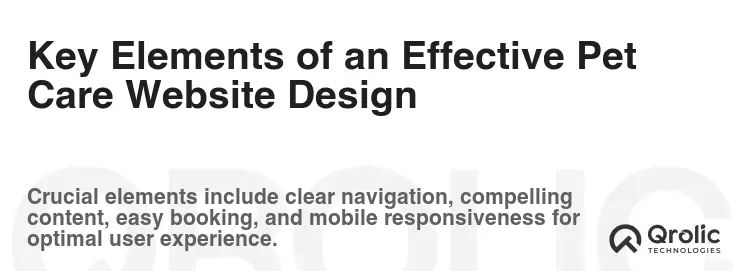
A successful website design for pet care services requires careful consideration of several key elements:
1. User-Friendly Navigation
- Intuitive Menu Structure: Ensure that your website’s navigation is clear, concise, and easy to understand. Visitors should be able to find what they’re looking for quickly and effortlessly.
- Mobile-Friendly Design: In today’s mobile-first world, it’s crucial that your website is fully responsive and optimized for viewing on all devices (smartphones, tablets, desktops).
- Clear Call-to-Actions (CTAs): Guide visitors towards desired actions with prominent and persuasive CTAs, such as “Book an Appointment,” “Request a Quote,” or “Contact Us.”
2. Visually Appealing Design
- High-Quality Images and Videos: Use professional-quality photos and videos of pets, your staff, and your facility to create a welcoming and trustworthy atmosphere.
- Consistent Branding: Maintain a consistent brand identity throughout your website, using your logo, colors, fonts, and overall style to reinforce your brand message.
- Clean and Uncluttered Layout: Avoid overwhelming visitors with too much information or visual clutter. A clean and organized layout enhances readability and user experience.
3. Engaging Content
- Compelling Copywriting: Use clear, concise, and engaging language to communicate your value proposition and address the needs and concerns of pet owners.
- Informative Service Descriptions: Provide detailed descriptions of each service you offer, highlighting the benefits and addressing any potential questions.
- Blog and Resources: Create a blog or resource section where you can share valuable information about pet care, health, and behavior. This can attract organic traffic and establish you as an expert.
4. Essential Functionality
- Online Booking System: Integrate an online booking system that allows clients to easily schedule appointments, view availability, and manage their bookings.
- Contact Form: Make it easy for visitors to contact you by including a contact form with relevant fields (name, email, phone number, message).
- Map and Directions: Provide a clear map and directions to your facility, making it easy for clients to find you.
- Secure Payment Gateway: If you offer online payments, ensure that you have a secure payment gateway to protect your clients’ financial information.
SEO Strategies for Pet Care Websites: Reaching Your Target Audience

Search engine optimization (SEO) is crucial for attracting new clients to your pet care business through organic search results. By implementing effective SEO strategies, you can increase your website’s visibility and reach a wider audience of pet owners looking for your services.
1. Keyword Research: Understanding What Pet Owners are Searching For
- Identify Relevant Keywords: Use keyword research tools (e.g., Google Keyword Planner, Ahrefs, SEMrush) to identify the keywords and phrases that pet owners are using to search for pet care services in your area. Focus on a mix of broad keywords (e.g., “dog grooming,” “pet boarding”) and long-tail keywords (e.g., “affordable dog grooming near me,” “reliable pet boarding for small dogs”).
- Analyze Competitor Keywords: Analyze the keywords that your competitors are targeting to identify opportunities for differentiation and optimization.
- Consider Local Keywords: Emphasize local keywords that include your city or region (e.g., “veterinary clinic in [city name],” “dog walker in [neighborhood name]”).
2. On-Page Optimization: Making Your Website Search Engine Friendly
- Optimize Title Tags and Meta Descriptions: Craft compelling and keyword-rich title tags and meta descriptions for each page of your website. These elements are displayed in search results and can significantly impact click-through rates.
- Use Header Tags (H1-H6): Use header tags to structure your content and highlight important keywords. Use only one H1 tag per page and use H2-H6 tags for subheadings.
- Optimize Image Alt Text: Add descriptive alt text to all images on your website, using relevant keywords to improve image search rankings and accessibility.
- Internal Linking: Create internal links between relevant pages on your website to improve navigation and distribute link equity.
- Mobile Optimization: Ensure that your website is fully responsive and optimized for mobile devices. Google prioritizes mobile-friendly websites in search rankings.
- Website Speed: Optimize your website’s loading speed by compressing images, leveraging browser caching, and using a content delivery network (CDN).
3. Content Marketing: Creating Valuable Resources for Pet Owners
- Blog Posts: Regularly publish high-quality blog posts on topics related to pet care, health, and behavior. This can attract organic traffic, establish you as an expert, and provide valuable content for your social media channels.
- Informative Articles: Create informative articles on specific topics, such as “How to Choose the Right Dog Food” or “Tips for Traveling with Your Cat.”
- Videos: Create engaging videos that showcase your services, facility, and staff. Videos can be highly effective in attracting attention and building trust.
- Infographics: Create visually appealing infographics that present complex information in an easy-to-understand format.
4. Link Building: Earning Authority and Credibility
- Local Directories: List your business in relevant local directories (e.g., Yelp, Google My Business, Angie’s List) and ensure that your listings are accurate and consistent.
- Industry Partnerships: Partner with other businesses in the pet care industry (e.g., pet supply stores, groomers, trainers) to exchange links and cross-promote each other’s services.
- Guest Blogging: Write guest posts for other websites in the pet care niche, providing valuable content and including a link back to your website.
- Earned Media: Earn media mentions from local news outlets or pet-related publications by providing expert commentary or participating in community events.
5. Local SEO: Targeting Pet Owners in Your Area
- Google My Business: Claim and optimize your Google My Business listing, ensuring that your business name, address, phone number, website URL, and hours of operation are accurate and up-to-date.
- Local Citations: Build local citations by listing your business in relevant online directories and business listings.
- Local Reviews: Encourage clients to leave reviews on Google, Yelp, and other review platforms. Positive reviews can significantly improve your local search rankings and attract new clients.
- Geo-Targeted Content: Create content that is specifically targeted to pet owners in your local area, such as blog posts about local dog parks or events.
Animal Service Web Development: Tailoring Your Website to Specific Needs

Animal service web development involves creating websites that are specifically tailored to the unique needs of businesses that provide services for animals, such as veterinary clinics, animal shelters, pet groomers, and dog trainers. These websites often require specialized features and functionality to effectively serve their target audience.
1. Veterinary Website Design: Caring for Pets Online
- Online Appointment Scheduling: Allow pet owners to easily schedule appointments online, reducing phone calls and streamlining the booking process.
- Patient Portal: Provide a secure patient portal where pet owners can access their pet’s medical records, view lab results, and communicate with their veterinarian.
- Emergency Information: Display emergency contact information prominently on your website, ensuring that pet owners can easily find help in times of need.
- Online Pharmacy: If you offer an online pharmacy, integrate it seamlessly into your website, allowing pet owners to easily order medications and supplies.
- Pet Health Library: Create a pet health library with articles and resources on common pet health conditions, vaccinations, and preventative care.
2. Animal Shelter Website Design: Finding Forever Homes
- Pet Adoption Listings: Create detailed pet adoption listings with photos, descriptions, and information about each animal’s personality and needs.
- Online Adoption Application: Allow potential adopters to submit an online adoption application, streamlining the adoption process.
- Donation Platform: Integrate a secure donation platform to allow supporters to easily donate to your shelter.
- Volunteer Sign-Up: Provide a volunteer sign-up form for individuals who are interested in volunteering their time at your shelter.
- Success Stories: Share success stories of animals who have been adopted from your shelter, showcasing the impact of your work.
3. Pet Grooming Website Design: Showcasing Style and Expertise
- Online Booking System: Allow pet owners to easily schedule grooming appointments online, selecting their desired services and appointment time.
- Grooming Portfolio: Showcase your grooming skills with a portfolio of before-and-after photos of pets you have groomed.
- Service Menu: Clearly display your grooming service menu with prices and descriptions of each service.
- Client Testimonials: Feature testimonials from satisfied clients, highlighting the quality of your grooming services.
- Product Recommendations: Recommend pet grooming products that clients can purchase to maintain their pet’s coat at home.
4. Dog Training Website Design: Building Better Bonds
- Course Descriptions: Provide detailed descriptions of your dog training courses, outlining the skills and behaviors that will be taught.
- Online Enrollment: Allow dog owners to enroll in your training courses online, selecting their desired course and payment option.
- Trainer Profiles: Showcase your trainers’ qualifications and experience, building trust and confidence in your services.
- Client Success Stories: Share success stories of dogs and their owners who have benefited from your training programs.
- Training Tips and Resources: Provide training tips and resources for dog owners to use at home, reinforcing the skills learned in your courses.
Veterinary Website Design: A Specialized Approach
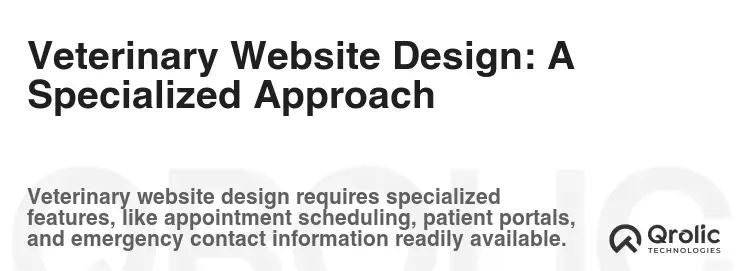
Veterinary website design requires a specialized approach that focuses on building trust, providing valuable information, and streamlining communication between veterinarians and pet owners. A well-designed veterinary website can help attract new clients, improve patient care, and enhance the overall client experience.
1. Building Trust and Credibility
- Professional Design: A professional and modern website design conveys competence and trustworthiness.
- Veterinarian Profiles: Showcase the qualifications and experience of your veterinarians, highlighting their expertise and specializations.
- Accreditations and Certifications: Display any accreditations or certifications that your clinic has earned, such as AAHA accreditation.
- Testimonials and Reviews: Feature testimonials from satisfied clients, highlighting the quality of care provided by your veterinarians.
2. Providing Valuable Information
- Pet Health Articles: Create a library of informative articles on common pet health conditions, vaccinations, and preventative care.
- Surgical Procedures: Describe the surgical procedures that you offer, explaining the benefits and risks of each procedure.
- Diagnostic Services: Outline the diagnostic services that you provide, such as X-rays, ultrasounds, and blood tests.
- Emergency Care Information: Provide clear and concise information about how to handle pet emergencies, including contact information and directions to your emergency clinic.
3. Streamlining Communication
- Online Appointment Scheduling: Allow pet owners to easily schedule appointments online, reducing phone calls and streamlining the booking process.
- Patient Portal: Provide a secure patient portal where pet owners can access their pet’s medical records, view lab results, and communicate with their veterinarian.
- Contact Form: Make it easy for pet owners to contact you by including a contact form with relevant fields.
- Email Newsletter: Offer an email newsletter to keep pet owners informed about pet health tips, clinic news, and special offers.
4. Key Features for Veterinary Websites
- Online Pharmacy Integration: If you offer an online pharmacy, integrate it seamlessly into your website, allowing pet owners to easily order medications and supplies.
- Telemedicine Platform: Consider integrating a telemedicine platform to offer virtual consultations with pet owners.
- Blog: Regularly publish blog posts on topics related to pet health and wellness.
- FAQ Section: Create a comprehensive FAQ section to answer common questions about your services and policies.
Optimizing the User Experience (UX) for Pet Owners

Creating a positive user experience (UX) is essential for attracting and retaining clients on your pet care website. By focusing on the needs and preferences of pet owners, you can create a website that is easy to use, informative, and engaging.
1. Understanding Your Target Audience
- Pet Owner Demographics: Consider the demographics of your target audience, such as age, income, and location.
- Pet Owner Needs: Understand the needs and concerns of pet owners, such as finding reliable care for their pets, accessing pet health information, and communicating with their veterinarian.
- User Research: Conduct user research to gather feedback on your website and identify areas for improvement.
2. Simplifying Navigation
- Intuitive Menu Structure: Ensure that your website’s navigation is clear, concise, and easy to understand.
- Search Functionality: Provide a search function to allow users to quickly find what they are looking for.
- Clear Call-to-Actions: Use clear and concise call-to-actions to guide users towards desired actions, such as booking an appointment or contacting you.
3. Creating Engaging Content
- High-Quality Images and Videos: Use professional-quality images and videos to showcase your services and facilities.
- Compelling Copywriting: Use clear, concise, and engaging language to communicate your value proposition.
- Informative Content: Provide valuable information about pet care, health, and behavior.
4. Ensuring Mobile Responsiveness
- Responsive Design: Ensure that your website is fully responsive and optimized for mobile devices.
- Mobile-Friendly Navigation: Use a mobile-friendly navigation menu that is easy to use on small screens.
- Fast Loading Speed: Optimize your website’s loading speed to ensure a smooth user experience on mobile devices.
5. Accessibility
- WCAG Compliance: Adhere to the Web Content Accessibility Guidelines (WCAG) to ensure that your website is accessible to users with disabilities.
- Alt Text for Images: Add descriptive alt text to all images on your website.
- Keyboard Navigation: Ensure that your website can be navigated using a keyboard.
Qrolic Technologies: Your Partner in Pet Care Website Design

Qrolic Technologies (https://qrolic.com/) is a leading web development company that specializes in creating high-quality websites for pet care businesses. With a deep understanding of the pet care industry and a commitment to excellence, Qrolic Technologies can help you create a website that attracts new clients, enhances your brand, and streamlines your operations.
Why Choose Qrolic Technologies?
- Expertise in Pet Care Website Design: Qrolic Technologies has a proven track record of creating successful websites for veterinary clinics, animal shelters, pet groomers, dog trainers, and other pet care businesses.
- Customized Solutions: Qrolic Technologies offers customized web development solutions that are tailored to your specific needs and goals.
- SEO Optimization: Qrolic Technologies understands the importance of SEO and will optimize your website to rank well in search results.
- Mobile-Friendly Design: Qrolic Technologies ensures that all websites are fully responsive and optimized for mobile devices.
- Ongoing Support: Qrolic Technologies provides ongoing support and maintenance to ensure that your website remains up-to-date and secure.
Services Offered by Qrolic Technologies
- Website Design and Development: Qrolic Technologies offers complete website design and development services, from initial concept to final launch.
- SEO Services: Qrolic Technologies provides comprehensive SEO services to improve your website’s search engine rankings.
- Content Marketing: Qrolic Technologies can help you create engaging content that attracts and retains clients.
- Social Media Marketing: Qrolic Technologies can help you develop a social media strategy to promote your business and engage with pet owners.
- E-Commerce Solutions: Qrolic Technologies can integrate e-commerce functionality into your website, allowing you to sell pet products and services online.
Measuring the Success of Your Pet Care Website
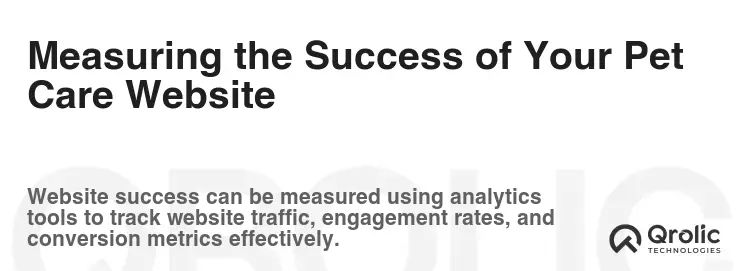
Once your website is live, it’s important to track its performance and make adjustments as needed. By monitoring key metrics, you can gain valuable insights into how your website is performing and identify areas for improvement.
1. Key Performance Indicators (KPIs)
- Website Traffic: Track the number of visitors to your website, as well as the sources of traffic (e.g., organic search, social media, referral links).
- Bounce Rate: Monitor the percentage of visitors who leave your website after viewing only one page. A high bounce rate may indicate that your website is not engaging or relevant to visitors.
- Conversion Rate: Track the percentage of visitors who complete a desired action, such as booking an appointment or contacting you.
- Time on Site: Monitor the average amount of time that visitors spend on your website. Longer time on site may indicate that your website is engaging and informative.
- Page Views per Session: Track the average number of pages that visitors view per session. Higher page views per session may indicate that your website is easy to navigate and contains valuable content.
2. Tools for Tracking Website Performance
- Google Analytics: Use Google Analytics to track website traffic, bounce rate, conversion rate, and other key metrics.
- Google Search Console: Use Google Search Console to monitor your website’s performance in Google search results.
- Heatmaps: Use heatmaps to visualize how visitors are interacting with your website and identify areas where they are clicking, scrolling, and spending time.
- A/B Testing: Use A/B testing to compare different versions of your website and identify which versions perform best.
3. Analyzing Data and Making Adjustments
- Identify Trends: Analyze your website’s performance data to identify trends and patterns.
- Identify Areas for Improvement: Use the data to identify areas where your website can be improved, such as navigation, content, or design.
- Make Adjustments: Make adjustments to your website based on the data you have collected.
- Monitor Results: Monitor the results of your adjustments to see if they have had a positive impact on your website’s performance.
By continuously monitoring your website’s performance and making adjustments as needed, you can ensure that your website is effectively serving your business goals and providing a positive experience for pet owners.
